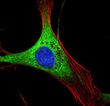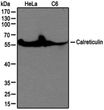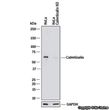Calreticulin (CALR) Rabbit Polyclonal Antibody
Frequently bought together (3)
Transient overexpression lysate of calreticulin (CALR)
USD 396.00
Other products for "Calreticulin"
Specifications
| Product Data | |
| Applications | WB |
| Recommended Dilution | Immunocytochemistry/ Immunofluorescence: 1:20-1:100, Immunohistochemistry-Frozen, Immunohistochemistry: 1:20, Immunohistochemistry-Paraffin: 1:20, Western Blot: 1:1000-1:10000, Simple Western: 1:500, Knockdown Validated: 1:2500, Knockout Validated |
| Reactivities | Human, Mouse |
| Host | Rabbit |
| Clonality | Polyclonal |
| Immunogen | A full-length protein to mouse Calreticulin [UniProt# P14211] |
| Formulation | Store at 4C short term. Aliquot and store at -20C long term. Avoid freeze-thaw cycles. |
| Concentration | lot specific |
| Purification | Whole antisera |
| Conjugation | Unconjugated |
| Storage | Store at -20°C as received. |
| Stability | Stable for 12 months from date of receipt. |
| Predicted Protein Size | 55 kDa |
| Gene Name | calreticulin |
| Database Link | |
| Background | Calreticulin (CRT) is a ubiquitous multifunctional calcium-binding protein which attaches to the surface of cells and implicates in signal transduction events associated with innate immunity, cell adhesion, and apoptosis. Because CRT lacks a trans-membrane domain, CD91 (LDLR-related protein 1) has been proposed as a candidate anchoring receptor for this protein. CRT is mainly localized in ER lumen, cytoplasmic granules as well as in sarcoplasmic reticulum lumen as a monomer where it forms a component of an EIF2 complex (CELF1/CUGBP1, CALR, CALR3, EIF2S1, EIF2S2, HSP90B1 and HSPA5) and interacts with GABARAP, NR3C1, PDIA3/ERp57, TRIM21 etc. CRT is a calcium-binding chaperone that promotes folding, oligomeric assembly and quality control in ER via the calreticulin/calnexin cycle. It interacts with DNA-binding domain of NR3C1 for facilitating its nuclear export. CRT is involved in maternal gene expression regulation and participates in oocyte maturation via regulation of calcium homeostasis. In immune system, cell surface CRT (csCRT) serves as the signal-transducing receptor for collectin family proteins which binds to foreign organisms or apoptotic cells through their globular heads, while their collagen-like tails bind to csCRT, which leads to phagocytosis. CRT located in the cytoplasm, at the cell membrane and extracellular matrix functions in many physiological processes, such as cell adhesion, phagocytosis, and tumor recognition. |
| Synonyms | cC1qR; CRT; HEL-S-99n; RO; SSA |
| Note | This Calreticulin antibody is useful for Western blot, where a band at ~55 kDa is seen. Note that Calreticulin has several reported isoforms that range from 48-62 kDa. ICC data from customer review. |
| Reference Data | |
| Protein Families | Druggable Genome, Secreted Protein, Transcription Factors |
| Protein Pathways | Antigen processing and presentation |
Documents
| Product Manuals |
| FAQs |
| SDS |
{0} Product Review(s)
0 Product Review(s)
Submit review
Be the first one to submit a review
Product Citations
*Delivery time may vary from web posted schedule. Occasional delays may occur due to unforeseen
complexities in the preparation of your product. International customers may expect an additional 1-2 weeks
in shipping.






























































































































































































































































 Germany
Germany
 Japan
Japan
 United Kingdom
United Kingdom
 China
China







